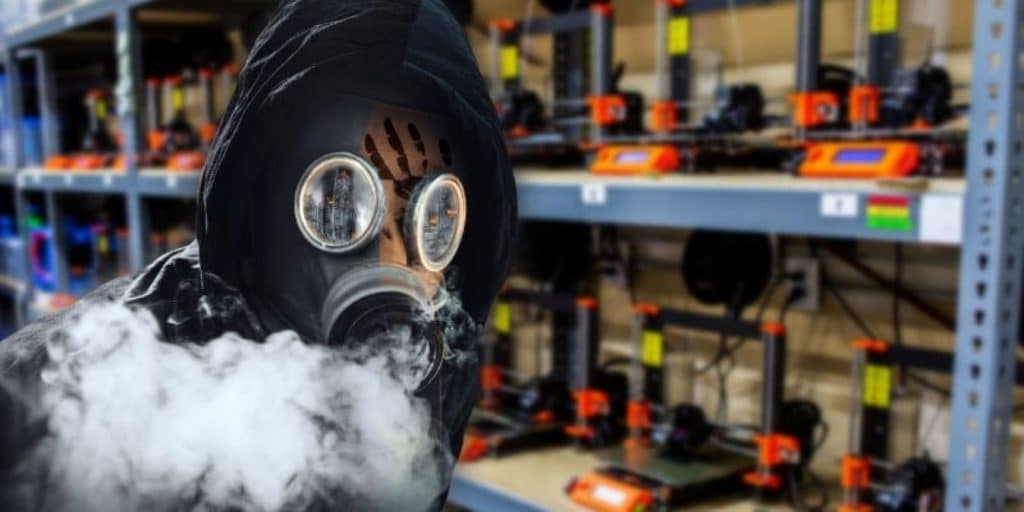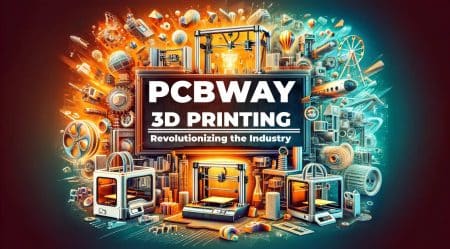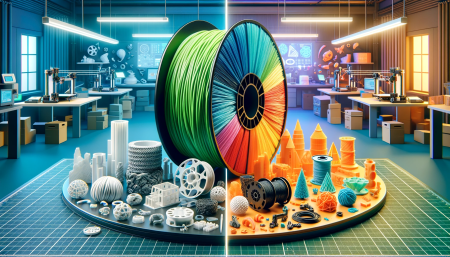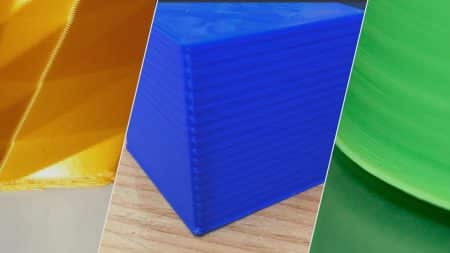3D printers are becoming more widely used in both homes and businesses. This raises the question of whether or not they are entirely human-friendly. After all, fused deposition modeling (FDM) 3D printing is based on melting plastic. This raises concerns about 3D printing safety and long-term exposure to fumes from 3D printers.
This article will learn about the many health problems regarding 3D printing. We’ll look at the various filaments and their safety. Then we’ll talk about some of the ways you may reduce the risks of utilizing a 3D printer. This article aims not to scare you away from 3D printing but to make you better aware of the risks and protective precautions you can take.
What are the dangers of 3D printer fumes?

3D printer fumes are the vapors of a variety of substances. Volatile organic compounds (VOCs) and ultrafine particles (UFPs) are the two main components of 3D printer fumes. The scent you get when 3D printing with PLA, ABS, or any other filament is caused by the release of chemicals in those filaments.
At room temperature, VOCs are a mixture of substances with high vapor pressure. The sweet smell of PLA filament, the agreeable perfume of melted ABS, and the pleasant scent of fresh paint are caused by VOCs being released into the air. Although VOCs are not life-threatening, long-term exposure to them can result in serious adverse effects.
UFPs have a diameter of less than 0.1 µm (100 nm). Due to their small size, they are notoriously difficult to filter out. These particles enter our bodies through our lungs, causing irritation in the nasal passages and eyes.
The increased release of VOCs when employing ABS, Polycarbonate and Nylon filaments was demonstrated in a 2016 study. Another study on ultrafine particle emissions identifies 3D printers as major UFP emitters.
Operating a 3D printer emits pollutants into the environment. Are these, however, harmful or hazardous to your health?
The short answer is yes, 3D printer emissions are dangerous. 3D printers, on the other hand, can employ a variety of filament materials, each of which is made up of different compounds. As a result, the gases released by these filaments differ.
Researchers analyzed the various VOCs released by different filaments in the same 2016 research report stated above.
Let’s take a closer look at the most popular plastic filaments.
ABS Filament 3D Printer Fumes
ABS (Acrylonitrile-Butadiene-Styrene) is a popular 3D printing material among amateurs and experts. It has outstanding strength and rigidity, and its strong temperature tolerance makes it an excellent material for practical applications.
Compared to printing with other 3D printing filaments, ABS produces more UFPs (2 1010 to 9 1010 particles per minute). ABS filaments have several drawbacks, one of which is that when they melt, they emit Styrene, a potentially toxic and carcinogenic VOC. Nasalgia, headaches, and weariness have also been linked to long-term exposure to ABS fumes.
PLA Filament 3D Printer Fumes
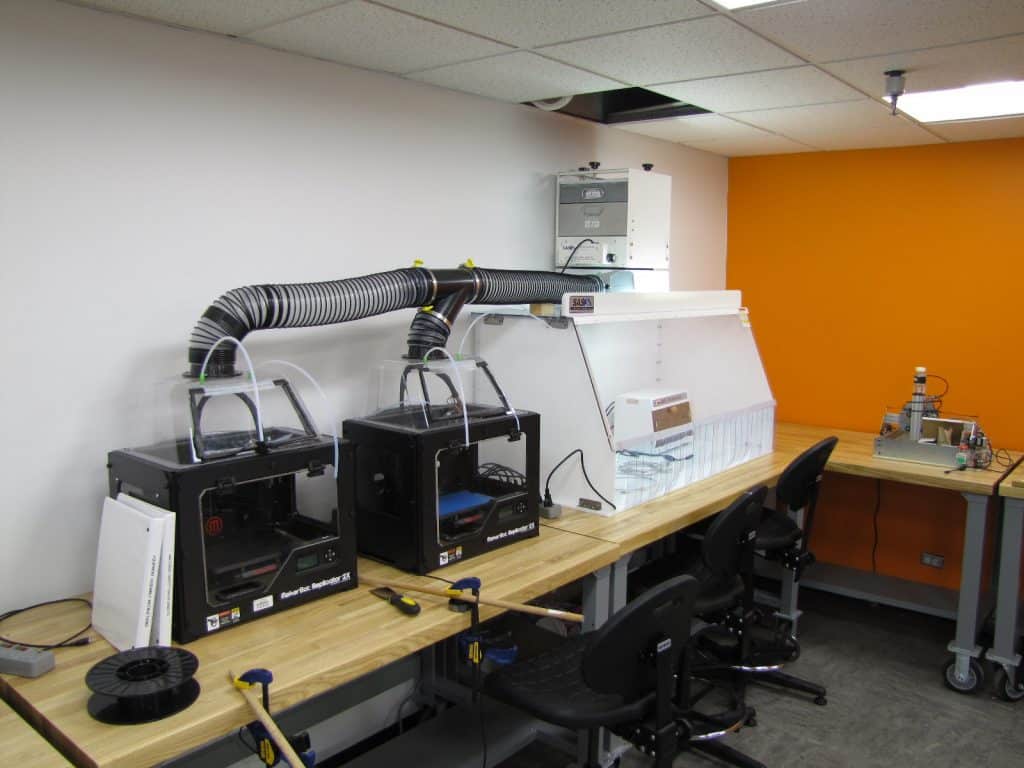
PLA is one of the most often used 3D printing filaments in hobbyist 3D printers. Corn starch, sugar, or maize are the main ingredients. PLA is a relatively sustainable 3D printing plastic since these materials are renewable raw materials.
Lactide is released into the atmosphere when the PLA filament is melted. However, this is a non-toxic substance that is relatively safe to handle. Compared to other 3D printing materials, PLA emits few VOCs and UFPs. However, long-term exposure to PLA fumes should be avoided because their long-term effects are uncertain.
PETG Filament 3D Printer Fumes
PETG (Polyethylene Terephthalate Glycol) is a popular 3D printing fiber. It is a single substance that combines the convenience of printing with the chemical and mechanical resilience of PLA and ABS.
According to a recent study, PETG releases harmful and carcinogenic compounds such as ethylbenzene and Styrene. This study cannot definitively quantify the concentration and emission of VOCs and UFPs nonetheless advises caution when it comes to long-term exposure to PETG vapors.
Nylon Filament 3D Printer Fumes
Nylon is primarily used in 3D printing for industrial purposes. It is much more durable and resistant to wear and tear than ABS filament. However, it also emits hazardous gases, with Caprolactam accounting for over 90% of the total.
Even though the EPA has not classified Caprolactam as a carcinogenic substance, long-term exposure can irritate the eyes and nose and also cause respiratory issues in people. The emission rate of VOCs while 3D printing Nylon was also found to be the highest, at 180 g/min, according to the 2016 study. This shows that even short-term exposure to these gases could have unpleasant printing adverse effects.
Resin 3D Printer Fumes

Resin 3D printing does not melt any materials; instead, a light source, such as an LCD screen or a laser, cures the 3D printer resin. Because the resin 3D printing process is infamous for its unpleasant odor, most of them come with a tightly sealed container. Air filtration devices are included in some of the best resin printers.
Although the VOCs emitted during resin 3D printing are substantially lower than those emitted during FDM printing, a recent study published by Chemical Insights revealed that harmful substances are released. During the resin 3D printing process, formaldehyde (a carcinogen), acetaldehyde, and methyl isobutyl ketone are emitted.
Even though these substances are far within the acceptable limits, extended contact with this mixture of chemicals can irritate the eyes and skin of vulnerable people.
How can you protect yourself from the dangers of 3D printer fumes?
We’ve recently realized that 3D printer fumes do pose a threat. While they are not immediately fatal, we must take safety and health precautions to enjoy the 3D printing pastime while minimizing any hazards. We’ll go through some of the tactics you may utilize to have a worry-free 3D printing experience in this part.
Make Sure Your Workspace is Well Ventilated
When 3D printers are in use, they release a continual stream of VOCs and UFPs, found in all of the studies. The dangers posed by these gases are more related to their concentration in the air than to the compounds themselves.
A single 3D printer in a closed room can be more dangerous than numerous 3D printers in a well-ventilated workspace. Using air filters, fans, and windows, the goal is to provide adequate ventilation in the workplace. This reduces the concentration of hazardous substances in the air and improves the room’s air quality.
Get a Closure for Your 3D Printer

Open-frame 3D printers are popular among hobbyists. This saves manufacturers money on the costs of an enclosed construction. This means that the 3D printer emits harmful gases directly into the atmosphere when used.
You can prevent this problem if you use enclosed 3D printers. These effectively confine VOCs and UFPs, preventing them from freely dispersing throughout your space. Some enclosed printers include a filtering system as well as fans.
Enclosures reduce filament smell and printing noises and restrict the transfer of dangerous gases into the workspace.
However, because these 3D printers can be costly, many consumers are willing to accept the trade-off with the open-frame design. You can, however, choose from a variety of existing DIY 3D printer enclosure options.
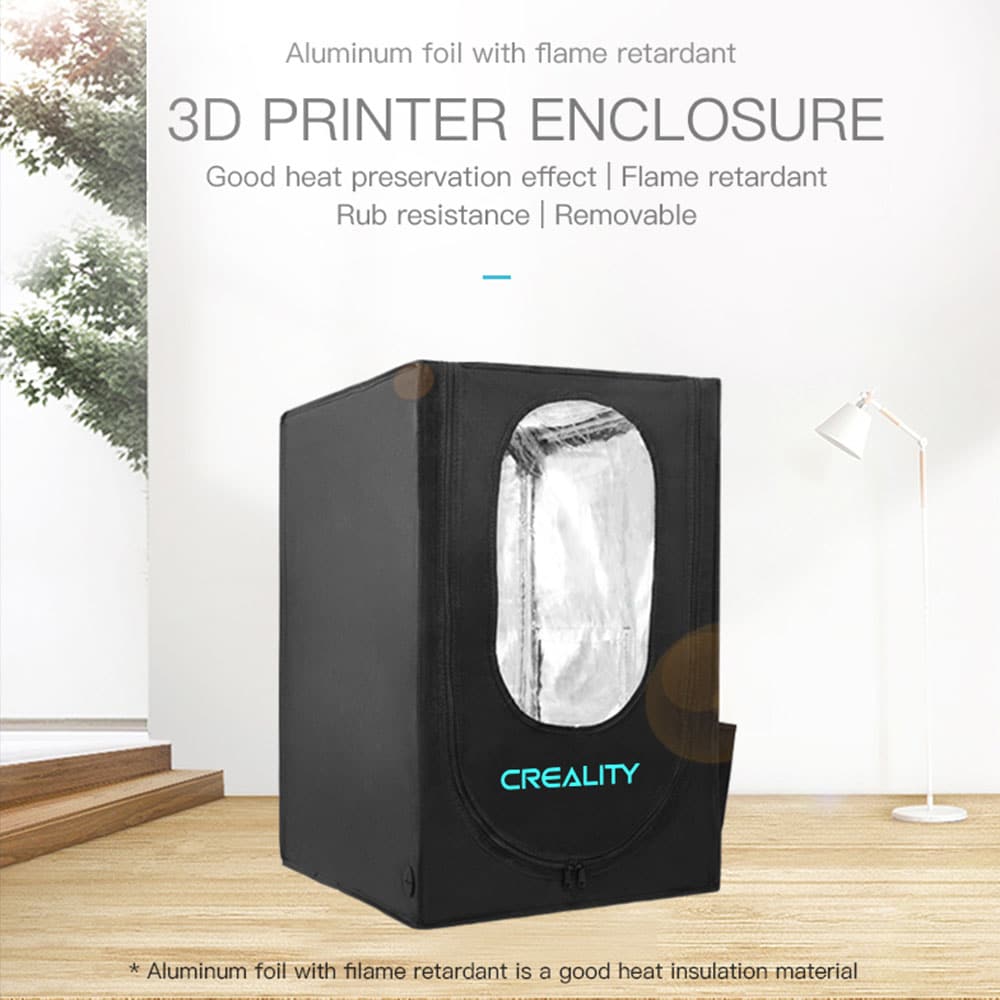
Creality even sells genuine enclosures for their 3D printers, such as the well-known Ender 3, which you may update when you’re ready. It’s just one of the many Ender 3 or Ender 5 enhancements you may make to improve your 3D printing experience.
You may also build your own DIY 3D printer enclosure if you are prepared to spend time and effort. Other designs are available, such as this IKEA Lack enclosure, which is compatible with a wide range of 3D printers.
3D Print with a more environmentally friendly material
If you don’t want to deal with harmful 3D printer fumes, the best option is to avoid the 3D printer filament that emits them. ABS and PETG are made up of a complicated mix of hazardous chemicals that emit significant volatile organic compounds (VOCs) into the air throughout the printing process. If you don’t have a specific need to 3D print with these polymers, it’s best to stay away from them.
After that, there’s PLA filament. PLA is beneficial for various reasons, the most important of which is that it is generally safe and releases little to no hazardous VOCs. Instead, you get a delicious fragrance from the PLA’s sugars dissolving. PLA filament is the safest alternative in environments where safety is paramount, such as the classroom, home office, or children’s bedroom. On the other hand, long-term exposure to PLA fumes, should be avoided because the long-term effects are unknown.
Monitor the air quality
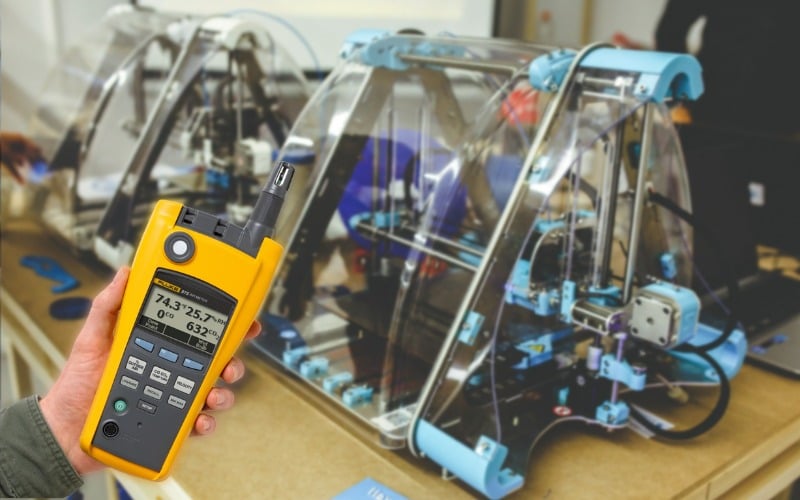
An excellent way to keep track of the air quality in your 3D printer’s workplace is to use an air quality monitor. You may not only collect safety and health-related information like VOC and CO2 levels. But you can also track humidity levels to ensure your filament doesn’t become too wet.
It can give you a sense of relaxation when it comes to dangerous 3D printer fumes. It also aids you in fine-tuning your ventilation and filtration systems to keep you in a safe zone. You don’t have to guess about air quality; instead, you can look at the statistics to discover if what you’re doing is safe.
Choose the Best Place for Your 3D Printer
A well-ventilated workspace and the best placement for your 3D printer go hand in hand. A garage workshop is usually the best place for your 3D printer. VOC and UFP concentrations may be kept low in a garage since it is well ventilated and has a large volume. You can also opt-out of staying in it while the 3D printer is running.
An enclosure and a robust ventilation system are required if you plan to use the printer in your living room or bedroom. You don’t want to risk harming your 3D prints or jeopardizing their long-term health by using PETG or ABS filament. You should also avoid placing the 3D printer near the children’s area.
Purifier of the air
An air purifier is an excellent instrument for removing harmful poisonous particles. If you’re planning on printing indoors, they’re a must-have. These purifiers filter out hazardous VOCs and eliminate odors and deliver clean air to your workplace. The filters in these purifiers are the most critical component, so let’s look at the two most prevalent types of filters.
HEPA (High-Efficiency Particulate Air) Filters

High-Efficiency Particulate Air Filter (HEPA) is an acronym for High-Efficiency Particulate Air Filter. In theory, the HEPA filter eliminates about 99.97 percent of air particles with a diameter of 0.3 microns. You should obtain a HEPA filter with a MERV value of 17 or above, as these are the most effective against the UFPs from the 3D printer. The MERV rating of these filters corresponds to the particle size they can filter out.
Filters made of carbon
Activated carbon is used in carbon filters to filter out particles. Carbon filters, unlike HEPA filters, process foul-smelling compounds and effectively remove any odors or dangerous gases from the air.
These filters are typically used in tandem with HEPA filters. The HEPA filters trap any dust, chemicals, or pollen in the air, and the carbon filters clean it up.
Our choice

The Levoit Core 300 air purifier is one of the most affordable and effective available air purifiers. With a noise level of only 24 dB, it runs virtually softly. VOCs, UFPs, dust, poisons, smoking, and pet hair may be filtered out using HEPA and carbon filters.
Thanks to its sleek design and modest size, this air purifier is an ideal complement for any small-to-medium-sized 3D printing environment.
A Window Fan

Finally, installing a window fan is the most straightforward solution. Window fans are an excellent way to circulate air in a room and offer enough ventilation in a workspace. When positioned at a window opening, the fan guarantees that enough fresh air enters the room to prevent VOCs and ultrafine particles from accumulating.
FAQ of 3D Printer Fumes

Conclusion
3D printing is a fantastic and enjoyable pastime. However, you must take specific care to enjoy it fully and stress-free. While we can’t completely prevent 3D printer fumes, we can certainly reduce them and avoid some problems.
To keep oneself safe from hazardous and harmful 3D printing fumes, incorporate a well-ventilated workspace, an air purifier, and a 3D printer with an enclosure into your setup. While you can never completely eliminate all risks, these are sufficient to provide a worry-free vacation.
If none of these solutions are feasible for you, the safest option is to stay with PLA filament.
We hope you found this article informative and engaging. If you’re as passionate about 3D printing as we are, we’d love to hear your thoughts! Join the conversation by leaving a comment below. Share your experience with your 3D printer setup and how you’ve tackled ventilation and fumes. Your insight might just be the game-changer someone else is looking for!
Don’t miss out on our latest updates, expert tips, and exclusive deals. Join our newsletter now and be a part of our vibrant, innovative community. With our newsletter, you’ll always stay one step ahead in the fast-paced world of 3D printing.
Click Here to Join our Newsletter
Every idea, every question, every new step you take in your 3D printing journey, enriches our community. So, share your thoughts and let’s keep exploring the amazing world of 3D printing together!



